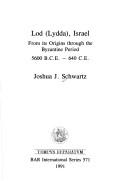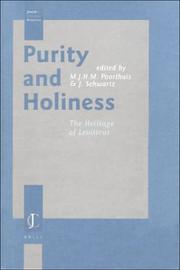| Listing 1 - 4 of 4 |
Sort by
|

ISBN: 0860547213 Year: 1991 Publisher: Oxford : BAR,
Abstract | Keywords | Export | Availability | Bookmark
 Loading...
Loading...Choose an application
- Reference Manager
- EndNote
- RefWorks (Direct export to RefWorks)
Excavations (Archaeology) --- -Rabbis --- -Jewish rabbis --- Clergy --- Jewish scholars --- Judaism --- Archaeological digs --- Archaeological excavations --- Digs (Archaeology) --- Excavation sites (Archaeology) --- Ruins --- Sites, Excavation (Archaeology) --- Archaeology --- Functionaries --- Lod (Israel) --- -Lod (Israel) --- -History --- Antiquities --- Rabbis --- Jewish rabbis --- Lydda, Israel --- Lydda (Israel) --- Lūd (Israel) --- Ludd (Israel) --- Lidd (Israel) --- Antiquities. --- History.

ISSN: 13882074 ISBN: 9004114181 9004421394 9789004114180 9789004421394 Year: 2000 Volume: 2 Publisher: Leiden;Boston BRILL
Abstract | Keywords | Export | Availability | Bookmark
 Loading...
Loading...Choose an application
- Reference Manager
- EndNote
- RefWorks (Direct export to RefWorks)
Purity has long been recognized as one of the essential drives which determines humankind's relationship with the holy. Codes of purity and impurity, dealing with such far-ranging topics as 'external stains' and 'inner remorse', represent the physical and 'bodily' side of religious experience and provide the key to the understanding of human orientation to nature, and the structure of society, including even relationships between the sexes. Starting with the Hebrew Bible, a number of articles study some rather neglected passages from both exegetical and cultural-anthropological standpoints. Next, it is shown that the concept of purity is far more central to the New Testament than previously thought. Luke is portrayed as a Jewish-oriented writer. The discussion of purity in Mark is compared with Rabbinical and Qumranic material. Patristic discussions of purity reflect both allegorical and literal interpretations, while rabbinical rulings display a fine sense for detail and realia. Biblical references to illness are interpreted both in Christian and Jewish traditions as a metaphor for immoral behavior. The present collection of studies proceeds far beyond other collections on purity, studying both the medieval and modern periods. Purity rules, in both Christian and Jewish society, do not disappear in the Middle Ages, but become increasingly stronger. Sometimes there appear unexpected and surprising similarities between both societies. Modern society sees a decline in the importance of purity, reflecting a growing ambiguous attitude to the relationship between the body and the holy. A feminist perspective is also provided, examining the intertwined relationship between religion, gender and power. Exegesis, archaeology, liturgy, anthropology and even architecture are all used to study the complex phenomena of purity in their religious and social dimensions from both Christian and Jewish perspectives.
Purity, Ritual --- Rabbinical literature --- Judaism --- History of doctrines --- Christianity --- Biblical teaching --- History and criticism --- 222.3 --- -Purity, Ritual --- -Rabbinical literature --- -Hebrew literature --- Jewish literature --- Ceremonial purity --- Clean and unclean --- Cleanliness, Ritual --- Purity, Ceremonial --- Ritual purity --- Rites and ceremonies --- Exodus. Leviticus. Numeri --- -History of doctrines --- -Exodus. Leviticus. Numeri --- -Ceremonial purity --- Hebrew literature --- Purity [Ritual ] --- Congresses --- History of doctrines. --- Biblical teaching. --- Purity, Ritual - Judaism - History of doctrines - Congresses. --- Purity, Ritual - Christianity - History of doctrines - Congresses. --- Purity, Ritual - Biblical teaching - Congresses. --- Rabbinical literature - History and criticism - Congresses.
Multi
ISSN: 18774970 ISBN: 9789004349865 9004349863 9789004352971 900435297X Year: 2017 Volume: 15 Publisher: Boston BRILL
Abstract | Keywords | Export | Availability | Bookmark
 Loading...
Loading...Choose an application
- Reference Manager
- EndNote
- RefWorks (Direct export to RefWorks)
This work discusses crucial aspects of the period between the two revolts against Rome in Judaea that saw the rise of rabbinic Judaism and of the separation between Judaism and Christianity. Most contributors no longer support the "maximalist" claim that around 100 CE, a powerful rabbinic regime was already in place. Rather, the evidence points to the appearance of the rabbinic movement as a group with a regional power base and with limited influence. The period is best seen as one of transition from the multiform Judaism revolving around the Second Temple in Jerusalem to a Judaism that was organized around synagogue, Tora, and sages and that parted ways with Christianity
Christian church history --- Jewish religion --- anno 100-199 --- anno 1-99 --- Judaism --- Christianity and other religions --- 296*82 --- Jews --- Religions --- Semites --- 296*82 Dialoog joden - christenen --- Dialoog joden - christenen --- Relations&delete& --- Christianity --- Religion --- Rome --- History --- Judaïsme --- --Christianisme --- --Relation --- --Antiquité --- --Congrès --- --2015 --- --Ramat-Gan, Israël --- --actes --- --Judaïsme --- --Christian church history --- --Judaism --- Relations --- Brotherhood Week --- Christianisme --- Relation --- Antiquité --- Congrès --- Ramat-Gan, Israël --- Christians --- Religious adherents --- Hebrews --- Israelites --- Jewish people --- Jewry --- Judaic people --- Judaists --- Ethnology --- Judaïsme
Book
ISBN: 0813756596 Year: 2020 Publisher: Geological Society of America
Abstract | Keywords | Export | Availability | Bookmark
 Loading...
Loading...Choose an application
- Reference Manager
- EndNote
- RefWorks (Direct export to RefWorks)
"This volume includes five geologic field-trip guides in the Los Angeles region associated with the 2020 GSA Cordilleran Section Meeting that was scheduled for May 2020, in Pasadena, California. The guides are organized in a generally counterclockwise order around the Los Angeles Basin. The first guide by Burgette et al. provides new slip rates, age constraints, and observations of the active Sierra Madre fault zone that borders the northern side of the San Gabriel and San Fernando Valleys. The Nourse et al. guide takes a new look at the San Gabriel Mountains from a basement and geomorphologic perspective. Further west, Keller et al. provide one of the first published field-trip guides focused on the 9 January 2018 Montecito debris flows that caused 23 deaths. The volume then moves south to Santa Cruz Island, where Davis et al. provide an updated review of the island's geology within the California borderlands. The final guide returns to the east, where Platt et al. present the unique geology of Santa Catalina Island with a focus on the subduction-related Catalina Schist"--
Geology --- Géologie --- Geology. --- Southern California.
| Listing 1 - 4 of 4 |
Sort by
|

 Search
Search Feedback
Feedback About UniCat
About UniCat  Help
Help News
News